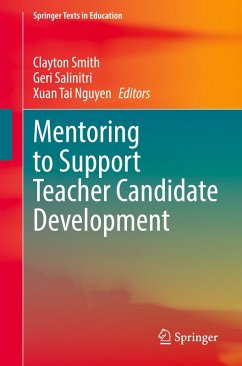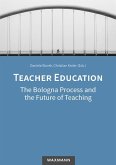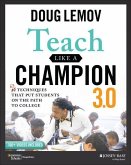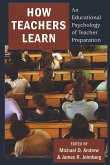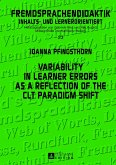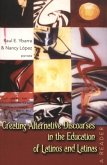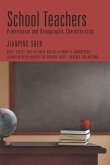Mentoring to Support Teacher Candidate Development
Herausgegeben:Smith, Clayton; Salinitri, Geri; Nguyen, Xuan Tai
Mentoring to Support Teacher Candidate Development
Herausgegeben:Smith, Clayton; Salinitri, Geri; Nguyen, Xuan Tai
- Broschiertes Buch
- Merkliste
- Auf die Merkliste
- Bewerten Bewerten
- Teilen
- Produkt teilen
- Produkterinnerung
- Produkterinnerung
This book explores the variety of ways in which mentoring can be used to support teacher candidate development. It provides an overview of how mentoring can be used in teaching practice, and specifically how it can be employed to support the development of a range of student types, including in-risk students, additional language students, and international learners. It focuses on the 'soft' or generic skills that enhance employability and the ability to work comfortably with others, such as communication skills, critical thinking, problem-solving, life-long learning, ethics, and leadership.…mehr
Andere Kunden interessierten sich auch für
![Teacher Education Teacher Education]() Teacher Education29,90 €
Teacher Education29,90 €![Teach Like a Champion 3.0 Teach Like a Champion 3.0]() Doug LemovTeach Like a Champion 3.026,99 €
Doug LemovTeach Like a Champion 3.026,99 €![How Teachers Learn How Teachers Learn]() How Teachers Learn40,50 €
How Teachers Learn40,50 €![How Teachers Learn How Teachers Learn]() How Teachers Learn137,35 €
How Teachers Learn137,35 €![Variability in Learner Errors as a Reflection of the CLT Paradigm Shift Variability in Learner Errors as a Reflection of the CLT Paradigm Shift]() Joanna PfingsthornVariability in Learner Errors as a Reflection of the CLT Paradigm Shift71,80 €
Joanna PfingsthornVariability in Learner Errors as a Reflection of the CLT Paradigm Shift71,80 €![Creating Alternative Discourses in the Education of Latinos and Latinas Creating Alternative Discourses in the Education of Latinos and Latinas]() Creating Alternative Discourses in the Education of Latinos and Latinas36,55 €
Creating Alternative Discourses in the Education of Latinos and Latinas36,55 €![School Teachers School Teachers]() School Teachers34,95 €
School Teachers34,95 €-
-
-
This book explores the variety of ways in which mentoring can be used to support teacher candidate development. It provides an overview of how mentoring can be used in teaching practice, and specifically how it can be employed to support the development of a range of student types, including in-risk students, additional language students, and international learners. It focuses on the 'soft' or generic skills that enhance employability and the ability to work comfortably with others, such as communication skills, critical thinking, problem-solving, life-long learning, ethics, and leadership. This book is designed to be used in pre-service teacher education programs, in-service teaching and beginning teacher induction.
Produktdetails
- Produktdetails
- Springer Texts in Education
- Verlag: Springer / Springer Nature Switzerland / Springer, Berlin
- Artikelnr. des Verlages: 89505982, 978-3-032-02332-2
- Seitenzahl: 772
- Erscheinungstermin: Oktober 2025
- Englisch
- Abmessung: 235mm x 155mm x 43mm
- Gewicht: 1189g
- ISBN-13: 9783032023322
- ISBN-10: 3032023327
- Artikelnr.: 74872776
- Herstellerkennzeichnung
- Springer-Verlag GmbH
- Tiergartenstr. 17
- 69121 Heidelberg
- ProductSafety@springernature.com
- Springer Texts in Education
- Verlag: Springer / Springer Nature Switzerland / Springer, Berlin
- Artikelnr. des Verlages: 89505982, 978-3-032-02332-2
- Seitenzahl: 772
- Erscheinungstermin: Oktober 2025
- Englisch
- Abmessung: 235mm x 155mm x 43mm
- Gewicht: 1189g
- ISBN-13: 9783032023322
- ISBN-10: 3032023327
- Artikelnr.: 74872776
- Herstellerkennzeichnung
- Springer-Verlag GmbH
- Tiergartenstr. 17
- 69121 Heidelberg
- ProductSafety@springernature.com
Clayton Smith is a professor in the Faculty of Education at the University of Windsor, Canada. Dr. Smith’s research interests include student mentoring of teacher candidates, international student teaching practices, and open educational resources. Geri Salinitri is an associate professor emeritus and former associate dean of the Faculty of Education at the University of Windsor. Dr. Salinitri’s research interests focus on adult education, student success, tutoring, and mentoring. Xuan Tai Nguyen brings practical and research-based insights to projects exploring the role of language, technology, and support in education. His work bridges pedagogy, linguistics, and computational methods to enhance teaching and learning. He focuses on using computational methods to improve language analysis, student support, and decision-making in education.
Part I: Introduction & Overview.- Chapter 1. Mentorship in Higher Education: A Pathway to Student Success.- Chapter 2. Beyond the Concrete: Understanding the Essential Role of Soft Skills for Teacher Candidates.- Chapter 3. Social and Emotional Learning and Teacher Candidate Mentoring.- Part II: Pre-Service Mentoring.- Chaoter 4. Outcomes of Peer Mentoring for Teacher Candidates in a Post-Sec-ondary Concurrent Education Program.- Chapter 5. Shifting the Pre-Service Teacher Role in the Mentoring Relationship Through Knowledge Brokering and Boundary Objects.- Chapter 6. Critical Incident Support Model for Decision-Making in Challeng-ing Mentorship Situations.- Chapter 7. Using Action Research as a Mentorship Framework for Teacher Can-didates.- Chapter 8. Positioning Students as Practicum Mentors: Strategies to Support Pre-Service Teachers Professional Learning.- Chapter 9. Exploring Extracurricular Opportunities: Mentoring Teacher Candi-dates in a University Robotics Club.- Chapter 10. The Art of Mentoring Trauma-Informed Educators: Considerations for Teacher Education Programs.- Chapter 11. Alongside and Together: The Role of Practicum Faculty Advisors in Mentoring Teacher Candidates.- Chapter 12. Revisioning New Teacher Education: The Nexus of University and School Partnerships for Transformative Mentorship.- Part III: Mentoring for Student Types.- Chapter 13. Professional Insights for the Successful Implementation of Peer-Mentoring Programs for Undergraduate Teacher Candidates.- Chapter 14. The Importance of Mentorship for Non-Indigenous New Teachers and Teacher Candidates: Moving Toward a Decolonized Classroom by Fostering Reflection, Growth, and Cultural Competency.- Chapter 15. Mentorship Dimensions: A Tool for Mentoring through Reflection in Teacher Education Practica.- Chapter 16. Take a Walk in My Shoes: The Story of Implementing a Reverse Mentoring Pilot at Queen s University Belfast.- Chapter 17. What if Mentors Were Among Us? Exploring the Potential for Crit-ical Transformative Mentorship in Teacher Education.- Chapter 18. Impactful Mentoring: Strategies for Effective Teacher Development for Teaching Additional Language Learner Students.- Chapter 19. Empowering Diverse Learners: Mentoring International, Additional Language, and At-Risk Teacher Candidates.- Chapter 20. Mentoring and New Teacher Efficacy.- Chapter 21. The Importance of Implementing Mentorship Programs for Black Pre-Service Teachers in Canadian Teacher Education and Induction Programs.- Part IV: Mentoring in Teacher Induction.- Chapter 22. Mentor-Embedded Professional Learning Communities (MEPLCs) as a Tool for Teacher Induction.- Chapter 23. Working Towards Change: The Impact of Mentor Development on Associate Teachers and Faculty Advisors.- Chapter 24. Japan s Teacher Induction: A Comparative Ethnographic Narrative of Exemplary Mentoring .- Chapter 25. The Impact of Applying the Principle of the New Teacher Induction Program (NTIP) on Mentoring New Early Childhood Educators.- Chapter 26. COVID-19 Mentorship and Systemic Change: A Dual Auto-Ethnography from a Small Ontario School Board.- Chapter 27. Scaffolding New Teacher Mentoring: A Duoethnographic Exploration of Complementary Models of Mentorship of Teacher Candidates in an Ontario Faculty of Education.- Chapter 28. Mentoring Programs to Enhance Early Career Professional Development.- Chapter 29. Enhancing Professional Learning: Mentorship and Collaborative Inquiry.- Chapter 30. Mentor s Professional Development through Their Mentoring: A Synthesis of Studies in Teaching and Teacher Education.- Chapter 31. Cultivating Growth-Mindset through Life-Long Learning to Advance In-Service Teachers Pedagogical Content Knowledge: Proposing a Framework for Canadian K-12 Teachers Induction Program.- Chapter 32. Supporting New Teachers Remotely: Electronic Mentoring.- Chapter 33. An Innovative School-University Professional Development Collaboration: Linking an Australian Regional University with a Local School.- Part V: Conclusion.- Chapter 34. From Theory to Practice in the Mentorship Journey: A Reflective Summary.
Part I: Introduction & Overview.- Chapter 1. Mentorship in Higher Education: A Pathway to Student Success.- Chapter 2. Beyond the Concrete: Understanding the Essential Role of Soft Skills for Teacher Candidates.- Chapter 3. Social and Emotional Learning and Teacher Candidate Mentoring.- Part II: Pre-Service Mentoring.- Chaoter 4. Outcomes of Peer Mentoring for Teacher Candidates in a Post-Sec-ondary Concurrent Education Program.- Chapter 5. Shifting the Pre-Service Teacher Role in the Mentoring Relationship Through Knowledge Brokering and Boundary Objects.- Chapter 6. Critical Incident Support Model for Decision-Making in Challeng-ing Mentorship Situations.- Chapter 7. Using Action Research as a Mentorship Framework for Teacher Can-didates.- Chapter 8. Positioning Students as Practicum Mentors: Strategies to Support Pre-Service Teachers Professional Learning.- Chapter 9. Exploring Extracurricular Opportunities: Mentoring Teacher Candi-dates in a University Robotics Club.- Chapter 10. The Art of Mentoring Trauma-Informed Educators: Considerations for Teacher Education Programs.- Chapter 11. Alongside and Together: The Role of Practicum Faculty Advisors in Mentoring Teacher Candidates.- Chapter 12. Revisioning New Teacher Education: The Nexus of University and School Partnerships for Transformative Mentorship.- Part III: Mentoring for Student Types.- Chapter 13. Professional Insights for the Successful Implementation of Peer-Mentoring Programs for Undergraduate Teacher Candidates.- Chapter 14. The Importance of Mentorship for Non-Indigenous New Teachers and Teacher Candidates: Moving Toward a Decolonized Classroom by Fostering Reflection, Growth, and Cultural Competency.- Chapter 15. Mentorship Dimensions: A Tool for Mentoring through Reflection in Teacher Education Practica.- Chapter 16. Take a Walk in My Shoes: The Story of Implementing a Reverse Mentoring Pilot at Queen s University Belfast.- Chapter 17. What if Mentors Were Among Us? Exploring the Potential for Crit-ical Transformative Mentorship in Teacher Education.- Chapter 18. Impactful Mentoring: Strategies for Effective Teacher Development for Teaching Additional Language Learner Students.- Chapter 19. Empowering Diverse Learners: Mentoring International, Additional Language, and At-Risk Teacher Candidates.- Chapter 20. Mentoring and New Teacher Efficacy.- Chapter 21. The Importance of Implementing Mentorship Programs for Black Pre-Service Teachers in Canadian Teacher Education and Induction Programs.- Part IV: Mentoring in Teacher Induction.- Chapter 22. Mentor-Embedded Professional Learning Communities (MEPLCs) as a Tool for Teacher Induction.- Chapter 23. Working Towards Change: The Impact of Mentor Development on Associate Teachers and Faculty Advisors.- Chapter 24. Japan s Teacher Induction: A Comparative Ethnographic Narrative of Exemplary Mentoring .- Chapter 25. The Impact of Applying the Principle of the New Teacher Induction Program (NTIP) on Mentoring New Early Childhood Educators.- Chapter 26. COVID-19 Mentorship and Systemic Change: A Dual Auto-Ethnography from a Small Ontario School Board.- Chapter 27. Scaffolding New Teacher Mentoring: A Duoethnographic Exploration of Complementary Models of Mentorship of Teacher Candidates in an Ontario Faculty of Education.- Chapter 28. Mentoring Programs to Enhance Early Career Professional Development.- Chapter 29. Enhancing Professional Learning: Mentorship and Collaborative Inquiry.- Chapter 30. Mentor s Professional Development through Their Mentoring: A Synthesis of Studies in Teaching and Teacher Education.- Chapter 31. Cultivating Growth-Mindset through Life-Long Learning to Advance In-Service Teachers Pedagogical Content Knowledge: Proposing a Framework for Canadian K-12 Teachers Induction Program.- Chapter 32. Supporting New Teachers Remotely: Electronic Mentoring.- Chapter 33. An Innovative School-University Professional Development Collaboration: Linking an Australian Regional University with a Local School.- Part V: Conclusion.- Chapter 34. From Theory to Practice in the Mentorship Journey: A Reflective Summary.

